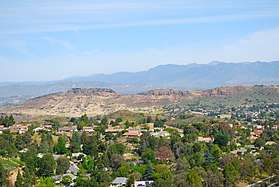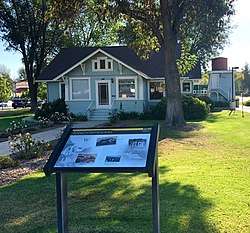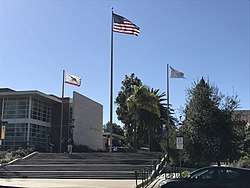Norwegian Colony (Thousand Oaks)

Norwegian Colony is a name used for a Norwegian community in Thousand Oaks, CA in the 1890's and early 20th century. They were among the first pioneers to settle in Conejo Valley, and the Norwegian Colony was perhaps the most successful colony in Ventura County at the time. The group of Norwegians escaped Norway due to lack of land and widespread starvation, and first settled in Santa Barbara in 1885. After being told about the cheap land in Conejo Valley, they relocated to what became the Norwegian Colony in 1890-91.[1] It was made up of five families: the Olsen, Andersen (Anderson), Pedersen (Pederson), Nilsen and Hansen families.
The settlement was short-lived. The Olsens lost 7 of their 10 children, while Ole Andersen, George Hansen and Lars Pedersen all died within a week during a diphtheria epidemic in 1901.[2][3]
One of their major contributions include the Norwegian Grade, which connects the Conejo Valley to the Santa Rosa Valley. The narrow, winding one-mile road was built over two years by men and boys of the colony.[4]
Several place names in Thousand Oaks derive from the Norwegian settlers. Olsen Road is for example named for the Olsen family, while Pederson Road and Pederson House and Water Tower are named after the Pederson family.[5] Pederson's House on California Lutheran University was constructed in 1913 and used by members of the colony. The house and surrounding area were donated to the school in order to make room for California Lutheran College. The house is now Ventura County Landmark No. 45 and Thousand Oaks City Landmark No. 3.[6]
Location

The Norwegian Colony was situated in northern Thousand Oaks. It was located where California Lutheran University (CLU) sits today and surrounding areas. The colony stretched from Mount Clef Ridge on the north and nearly to today’s Avenida de Los Arboles on the south. It was from Moorpark Road on the east for one mile, and on the west, the western boundaries of California Lutheran University.[7][8]
Early history
The lack of land and food in the fjords of western Norway forced many Norwegians to emigrate overseas during the late 19th- and early 20th century. Most of the Norwegians that ended up leaving for Thousand Oaks were from the small village of Stranda by Storfjorden. Several families followed when Lars Berge left for Santa Barbara in 1885.[9][1]
The Norwegian Colony began in the year of 1890, when five Norwegian families bought five tracts in the northern portion of Conejo Valley. They had been living in Santa Barbara for a few years, and was looking for cheap farm land. They originally wanted to buy land on Colonia Rancho, but the real estate was too expensive and three times the cost of land in Conejo Valley. They originally bought a total of 651.23 acres of uncultivated land from George Edwards.[10] They reportedly paid $3 per acre for flatlands, and $2 for hillsides.
Ole Andersen bought 199 acres, Lars Pedersen bought 111 acres, Nils Olsen 139 acres, Ole Nilsen 97 acres, and George Hansen bought 105 acres. The properties were located side by side on land which is now by the intersection of Moorpark- and Olsen Roads, surrounding California Lutheran University (CLU). After acquiring the land, Ole Nilsen was sent by the pioneers back to Norway to get their fiancées. Ole Andersen was the only one to not get married nor establish a family.[11]
The colony was short-lived: Ole Andersen, George Hansen and Lars Pedersen all died within a week of one another in 1901, due to a typhoid-[12] or diphtheria epidemic.[2]
Nils- and Ellen Olsen lost a seven of their ten children. Nils made a wooden casket for each of the children and buried them in his homemade cemetery. Paula Olsen, age ten, died in 1893. Nora, age six, died in 1900. Emma, age seven, died in 1903. Nora, age five, died in 1905. Laura, age seven, died in 1908. Ned, age eight, died in 1911. Lastly, Thora, age seven, died in 1912. Nicolay, Oscar and Peder Ludvik were the only to survive into adulthood.[3]
Families

The families were:[13]
- Farm Lot #1 (199 acres): Ole Andersen.
- Farm Lot #2 (111 acres): Lars- and Karen Pedersen.
- Farm Lot #3 (97 acres): Ole- and Elisabeth Nilsen.
- Farm Lot #4 (105 acres) George- and Lina Hansen.
- Farm Lot #5 (139 acres): Nils- and Ellen Olsen.
Norwegian Grade
Maybe the most notable contribution of the Norwegian Colony was the hand-made Norwegian Grade.[11] The Norwegians were farmers who were dependent on hauling their cattle and dry crops such as barley and wheat to Port Hueneme, Simi Valley and Moorpark. Their only routes to Port Hueneme were the out-of-the-way, treacherous Potrero- and Conejo Grades in Newbury Park. After George Hansen was badly injured at Potrero Grade, and in bed for a year because of injuries, the colony took the initiative to create their own road to the Santa Rosa Valley. They asked Ventura County for help, and was given a $60 donation to buy dynamite.[4][14][15]
The one-mile Norwegian Grade was completed in 1911. While it previously took residents of Conejo Valley two days to reach Port Hueneme by Potrero Grade, the steep Norwegian Grade had reduced the travel time by a full day.[16]
It was taken two photographs of the construction. One photograph taken by Ellen Olsen is on display at the Stagecoach Inn in Newbury Park, CA.[17]
California Lutheran University

130 acres of Lars- and Karen Pedersen’s former property were donated to establish California Lutheran College in 1959.[19][20][13] It was donated by land owner Richard Pederson, who was the son of Lars- and Karen Pederson.[21][22]
Lars Pedersen’s original house has been moved to the corner of Regent Ave and Faculty Street, about 500 ft. from where it was erected at the present site of Ahmanson Science Center. It is known as Pederson House and Water Tower and is designated Ventura County Historical Landmark #45 and Thousand Oaks Historical Landmark #3.[23] It was constructed in 1913, when the Pedersen's and Olsen's were the only remaining Norwegian settlers in Thousand Oaks.
References
- 1 2 Triem, Judith P. (1990). Ventura County: Land of Good Fortune. EZ Nature Books. Page 91. ISBN 9780945092162.
- 1 2 Bidwell, Carol A. (1989). The Conejo Valley: Old and New Frontiers. Windsor Publications. Page 31. ISBN 9780897812993.
- 1 2 Schroeder, Anne (2000). Branches on the Conejo: Leaving the Soil After Five Generations. Russell Dean & Company. Pages 33-34. ISBN 9781891954993.
- 1 2 Bidwell, Carol A. (1989). The Conejo Valley: Old and New Frontiers. Windsor Publications. Pages 30-31. ISBN 9780897812993.
- ↑ Begun, Miriam and Ruthanne Sprankling (2009). Ladies of The Conejo. Conejo Valley Historical Society. Page 134. ISBN 9780972523356.
- ↑ Sprankling, Miriam and Ruthanne Begun (2006). Historical Tour of the Conejo Valley. Newbury Park, CA: Conejo Valley Historical Society. Page 16. ISBN 0-9725233-4-0.
- ↑ "Norwegian Grade, built by hand, is turning 100". Retrieved 4 October 2017.
- ↑ Begun, Miriam and Ruthanne Sprankling (2009). Ladies of The Conejo. Conejo Valley Historical Society. Page 51. ISBN 9780972523356.
- ↑ Begun, Miriam and Ruthanne Sprankling (2009). Ladies of The Conejo. Conejo Valley Historical Society. Page 49. ISBN 9780972523356.
- ↑ Maulhardt, Jeffrey Wayne (2010). Conejo Valley. Arcadia Publishing. Page 8. ISBN 9780738580395.
- 1 2 Bidwell, Carol A. (1989). The Conejo Valley: Old and New Frontiers. Windsor Publications. Page 30. ISBN 9780897812993.
- ↑ Schroeder, Anne (2000). Branches on the Conejo: Leaving the Soil After Five Generations. Russell Dean & Company. Page 34. ISBN 9781891954993.
- 1 2 Schroeder, Anne (2000). Branches on the Conejo: Leaving the Soil After Five Generations. Russell Dean & Company. Page 131. ISBN 9781891954993.
- ↑ O’Brien, Tricia (2017). Thousand Oaks and Westlake Village. Arcadia Publishing. Page 80. ISBN 9781439661956.
- ↑ "Building of the Norwegian Grade from Conejo Valley to Camarillo 1909 to 1911". Retrieved 4 October 2017.
- ↑ Schroeder, Anne (2000). Branches on the Conejo: Leaving the Soil After Five Generations. Russell Dean & Company. Page 37. ISBN 9781891954993.
- ↑ Begun, Miriam and Ruthanne Sprankling (2009). Ladies of The Conejo. Conejo Valley Historical Society. Page 37. ISBN 9780972523356.
- ↑ Sprankling, Miriam (2002). Discovering the Story of The Conejo Valley. Newbury Park, CA: Conejo Valley Historical Society. Page 50. ISBN 0-9725233-0-8.
- ↑ Begun, Miriam and Ruthanne Sprankling (2009). Ladies of The Conejo. Conejo Valley Historical Society. Page 57. ISBN 9780972523356.
- ↑ University, California Lutheran. "Cal Lutheran at a Glance". Cal Lutheran. Retrieved 4 October 2017.
- ↑ University, California Lutheran. "Cal Lutheran to dedicate Pederson statue". Retrieved 4 October 2017.
- ↑ University, California Lutheran. "The Pederson Families". Cal Lutheran. Retrieved 4 October 2017.
- ↑ Begun, Miriam and Ruthanne Sprankling (2009). Ladies of The Conejo. Conejo Valley Historical Society. Page 134. ISBN 9780972523356.